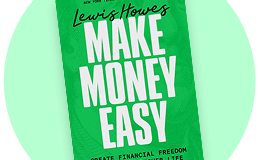Oprah Winfrey said, “Do what you have to do until you can do what you want to do.” And renowned language instructor Benny Lewis also said, “The difference between a stumbling block and a stepping stone is how high you raise your foot.”
Life’s obstacles can either make or break us, depending on how we perceive them: it’s easy to raise our feet high above those obstacles and leap over them if we have the right attitude and mindset. But if we look at life’s obstacles as stumbling blocks, we’ll struggle to accomplish anything or move in the direction of our dreams.
My guest today is Ryan Serhant, a successful real estate entrepreneur. He created the Serhant Team New Development Group: a prominent force in new residential, high-rise construction sales. Serhant has been ranked by the Wall Street Journal as the #1 sales team in New York for three consecutive years, averaging a billion dollars in sales annually.
In this episode, Ryan discusses the most important principle around making money; the secrets to winning any negotiation; how to make more money; the next three steps you should take if you’re financially stuck; and so much more! It’s an exciting episode around money and success, and I’m honored to have Ryan here at the School of Greatness. So, buckle up as we begin the class.
Who is Ryan Serhant?
Ryan Serhant is the founder and CEO of Serhant, a leading real estate company in New York City. After struggling as an actor, he entered real estate in 2008 — in the midst of the subprime mortgage industry collapse — as a solo agent without any experience in real estate selling. Today, he has more than 60 experienced agents under his leadership, and the Serhant Team has done more than $4 billion in sales and sold over 80 new development projects across Miami, Los Angeles, and New York.
Ryan is also a media mogul who created Sell it Like Serhant, a digital real estate education course that teaches students how to master the art of sales, and succeed in any profession. He has starred in several Bravo TV shows, such as the Emmy-nominated Million Dollar Listing. Ryan appeared alongside Noami Watts, Ben Stiller, and Adam Driver in the film While We’re Young. Now, he produces a YouTube Channel series, Listed: a first-of-its-kind real estate media network that features property listings and lifestyle passions.
As a community leader, Ryan Serhant inspires lifestyle and sales communities through writing and education. What started as a weekly newsletter in 2019 is now a committed community of hundreds of thousands of followers and subscribers, and fans of his book Big Money Energy. He guides people on how to rule at work, dominate in life, and make millions by evolving into the best versions of themselves.
Ryan Serhant is also a bestselling author, and he shares his top sales secrets in his book, Sell It Like Serhant: How to Sell More, Earn More, and Become the Ultimate Sales. He has several audiobooks, as well. In his audiobook, Six Reasons Balls Fall and Kill Your Deal, he teaches people how to transform a dead deal into a big win. His other audiobook, Transform People into Clients, is a good resource for sellers who want to enhance their skills in selling. I’m happy to have Ryan Serhant here with us to personally share some of his secrets around money and the art of negotiation.
The Art of Winning Any Negotiation
Every successful deal is a result of excellent negotiation skills. Those skills are what sets a successful agent apart from the average salesperson. So it goes without saying: if you want to be successful in any sales career, you’ll need to learn the art of negotiation.
For Ryan Serhant, the Principle of Least Interest best describes how to negotiate and win a deal.
“The one in the relationship who has all the power is the one who cares the least. And that is true for any business negotiation, house negotiation, promotion negotiation — anything.” – Ryan Serhant
According to Ryan, you’ll have more power and control of the entire negotiation if you are the party with the least interest. An example of how to make this strategy work for you is to commit to a position and stick with it. Of course, by sticking with your position and being unwilling to move or compromise, you could risk losing the transaction — however, your willingness to lose that transaction immediately puts you in the position of being the party with the least interest, giving you the edge during the negotiation. So decide what you want, and commit to it.
In the same vein, remember that when you negotiate, you can really only go in two directions: either you negotiate up, or you negotiate down.
When negotiating down, for example, you might be in a buying position where you’re trying to get the best quality product or service for the least amount possible. If you win a down negotiation, you could save yourself and your team a lot of money.
“I did negotiate down. … [It] is, by far, the easiest because all you have to do is not want it. … You have to be willing to walk away. You have to be willing to be okay with loss and know there are other options.” –Ryan Serhant
The principle of least interest can help you win a down negotiation as a buyer. You simply have to be willing to walk away from the negotiation if the team you’re trying to buy from refuses to make the sale at the price you want to pay. That willingness to walk away makes you the “least interested” party.
But wait — you can’t simply walk away from every negotiation at a loss, simply because you didn’t get your way, right?
Of course not. But, according to Ryan, if you have an abundant pipeline of people and companies you can do business with, you greatly improve your chances of winning both up and down negotiations more often.
Speaking of up negotiations, Ryan has some great insights about how we can increase our odds of making a high-end sale if we can convince our buyers that what we’re offering them is no longer a want, but a need.
Here’s how Ryan explains it:
“Negotiating somebody up is a different story. … It’s the fear of loss but on the total opposite side … [If] I got a good offer here, should I just take it and not go for more? But if you’re trying to get a buyer to pay more money, then you’re working on what we call the difference between a want and a need. So how do I make a want a need? …You have to then look for people’s points of fear. If he doesn’t get this, what triggers that fear? What’s he going to be afraid of?” –Ryan Serhant
In other words, there are two types of buyers — those who buy because they need what you’re selling, and those who buy because they want it.
During the negotiation, you have to identify what type of buyer you are transacting with. It’s easier to negotiate if the buyer needs it. Because in that scenario, you have the edge. But if they are buying because they want it, they can easily walk away since they don’t need it.
So, the challenge when you negotiate up is converting their wants into needs. To do that, pay attention to see if you can pinpoint things they might be afraid of (such as the consequences of purchasing a subpar product elsewhere) and fit those into the conversation. Get their fears on their mind.
How about you? What are your fears? If your fears include the fear of being financially stuck, you’re not alone.
The great news: Ryan has some really interesting insights into what you can do to get out of a financial rut.







